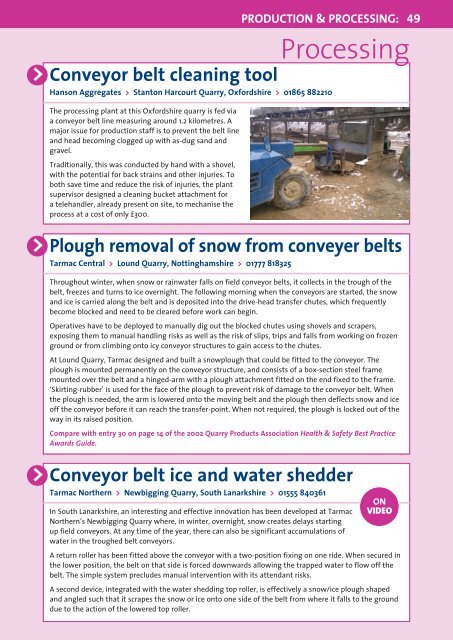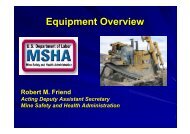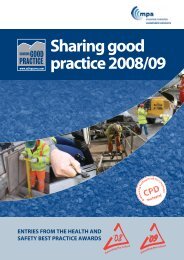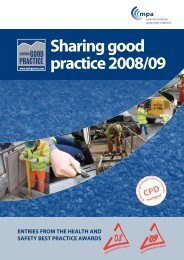Download PDF (2.3MB) - Safequarry.com
Download PDF (2.3MB) - Safequarry.com
Download PDF (2.3MB) - Safequarry.com
You also want an ePaper? Increase the reach of your titles
YUMPU automatically turns print PDFs into web optimized ePapers that Google loves.
production & processing: 49<br />
Conveyor belt cleaning tool<br />
Hanson Aggregates > Stanton Harcourt Quarry, Oxfordshire > 01865 882210<br />
Processing<br />
The processing plant at this Oxfordshire quarry is fed via<br />
a conveyor belt line measuring around 1.2 kilometres. A<br />
major issue for production staff is to prevent the belt line<br />
and head be<strong>com</strong>ing clogged up with as-dug sand and<br />
gravel.<br />
><br />
Traditionally, this was conducted by hand with a shovel,<br />
with the potential for back strains and other injuries. To<br />
both save time and reduce the risk of injuries, the plant<br />
supervisor designed a cleaning bucket attachment for<br />
a telehandler, already present on site, to mechanise the<br />
process at a cost of only £300.<br />
Plough removal of snow from conveyer belts<br />
Tarmac Central > Lound Quarry, Nottinghamshire > 01777 818325<br />
Throughout winter, when snow or rainwater falls on field conveyor belts, it collects in the trough of the<br />
belt, freezes and turns to ice overnight. The following morning when the conveyors are started, the snow<br />
and ice is carried along the belt and is deposited into the drive-head transfer chutes, which frequently<br />
be<strong>com</strong>e blocked and need to be cleared before work can begin.<br />
Operatives have to be deployed to manually dig out the blocked chutes using shovels and scrapers,<br />
exposing them to manual handling risks as well as the risk of slips, trips and falls from working on frozen<br />
ground or from climbing onto icy conveyor structures to gain access to the chutes.<br />
At Lound Quarry, Tarmac designed and built a snowplough that could be fitted to the conveyor. The<br />
plough is mounted permanently on the conveyor structure, and consists of a box-section steel frame<br />
mounted over the belt and a hinged-arm with a plough attachment fitted on the end fixed to the frame.<br />
‘Skirting-rubber’ is used for the face of the plough to prevent risk of damage to the conveyor belt. When<br />
the plough is needed, the arm is lowered onto the moving belt and the plough then deflects snow and ice<br />
off the conveyor before it can reach the transfer-point. When not required, the plough is locked out of the<br />
way in its raised position.<br />
><br />
Compare with entry 30 on page 14 of the 2002 Quarry Products Association Health & Safety Best Practice<br />
Awards Guide.<br />
Conveyor belt ice and water shedder<br />
Tarmac Northern > Newbigging Quarry, South Lanarkshire > 01555 840361<br />
In South Lanarkshire, an interesting and effective innovation has been developed at Tarmac<br />
Northern’s Newbigging Quarry where, in winter, overnight, snow creates delays starting<br />
up field conveyors. At any time of the year, there can also be significant accumulations of<br />
water in the troughed belt conveyors.<br />
on<br />
video<br />
A return roller has been fitted above the conveyor with a two-position fixing on one ride. When secured in<br />
the lower position, the belt on that side is forced downwards allowing the trapped water to flow off the<br />
belt. The simple system precludes manual intervention with its attendant risks.<br />
A second device, integrated with the water shedding top roller, is effectively a snow/ice plough shaped<br />
and angled such that it scrapes the snow or ice onto one side of the belt from where it falls to the ground<br />
due to the action of the lowered top roller.













